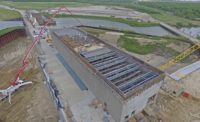When R.L. “Dick” McComish joined Electrical Consultants Inc. in 1990, he hardly expected that someday, as its future president and CEO, he would be meeting a payroll of nearly 500 people. Back then, McComish was employee No. 5. With luck, he thought ECI might grow into a small, well-respected regional designer of transmission lines, substations and other elements of the electric-power industry.
Instead, Billings, Mont.-based ECI now completes between 150 and 200 projects a year in the U.S. and Canada for both electric power and telecommunications providers. It operates from 17 offices in the U.S. and counts some of the largest utilities in the country among its steady customers. According to McComish, ECI has grown at a 20% compound rate every year since he joined the firm—and it has never had a layoff.
At the heart of the company’s growth, McComish says, is a penchant for innovation and a drive to provide customers with more than they expect. He says customers frequently applaud ECI’s meticulous drawings and the way its experts encourage clients to consider offbeat solutions to design problems.
David Anderson, ECI’s vice-president for strategic development, concurs.
“There’s always got to be a better way to do things, a more cost-effective way to do things, without sacrificing engineering principles,” Anderson says. “We have strived to do that, and I think we’ve found that good balance.”
He notes that certain clients bring rigid design standards and specifications and don’t want anything new. Even then, he says, “That doesn’t mean we won’t present an alternative and say, ‘Have you thought about the potential cost savings or the efficiency savings by doing something differently?’ That’s what we bring to the table, and we do it continually.”
However, Gary Bowles, the company’s executive vice president for transmission design and engineering, says it is imperative to offer innovation respectfully. Some 40 years ago, as a young engineer with Utah Power & Light (now Rocky Mountain Power), he was frequently annoyed by consultants eager to show off their knowledge.
“When we came into consulting, I thought, ‘I don’t want to be one of those guys,’” Bowles says. “I want to be the kind of guy who will come in and be able to feed off the current expertise that the utilities have. Because in my mind, all of these people are good at what they do or they wouldn’t have those jobs .… That’s kind of our culture, to provide a service and make them feel like it’s added a lot of value, without being intimidating.”
Methodical Design
ECI’s culture also involves painstaking controls throughout design—part of what Robert Delaney, the company’s vice president for substations, calls a “quality-first atmosphere.” It’s reflected in the company’s drawings, specifications and clearly stated details.
“It isn’t the quickest way to get it done,” Delaney observes. “But it’s a better way for having that permanent record.”
“It’s kind of methodical,” Bowles adds, explaining the company’s design procedures, which include detailed check sheets that prevent engineers and others from overlooking critical questions at every stage. Scheduling is maintained through Oracle Corp.’s Primavera package. The company provides dedicated quality-control time at various points for reviewing accuracy and completeness.
“It helps us not have to do rework, (and) it helps us not have to back up and start things differently, because each time we get to a specific place in our process, we have a thorough review of it,” Bowles says.
The initial assessment involves three people: the designer, the designer’s supervisor and the project manager. In Bowles’ words, the result is “a set process all the way through, where everybody’s involved, and we can be sure that the product we’re producing is correct, accurate and the direction we want to go in.”
Ultimately, senior management weighs in as well. McComish says the firm’s principals, while also focusing on the high-level aspects of operating the company, “still spend 50% of their time involved in oversight of technical work. And I believe that makes an incredible difference in quality .… It’s not uncommon for the principal to see something and say, ‘This isn’t good enough for ECI,’ and it goes back to the design team, even though the engineering team felt it was at the stage where it was ready to issue for construction. So I think we catch things because of this philosophy of a greater level of senior oversight.”
Occasionally, errors still happen. “We’re all human,” McComish says. “When things do happen, you have to care. ‘Care’ seems like such a simple word, but really you have to understand the definition that I mean, and that is you respond immediately …. You do whatever you have to do because it’s costing the customer money if the [construction] crew’s sitting around out there.”
Beyond Pure Design
Since 2000, ECI has been involved in electric power and telecommunications construction as well as design through its wholly owned engineering, procurement and construction (EPC) subsidiary, EPC Services Co. (EPCS). The firm performs construction and construction management for electric utilities, telecommunications providers and electric-power developers (primarily for solar- and wind-based generation) and builds only what ECI has designed.
Anderson says the thorough integration between ECI and EPCS contributes to quality and savings on jobs that tend to be highly complex.
“It’s so much easier to be cost effective and efficient when you’re under the same roof,” Anderson says. “If our EPC folks want to come over and discuss or even holler at our engineering staff, we’re right through a couple of doors. And, on the other hand, from the engineering perspective, if there are issues with materials or something where you want to question whether this is really a good choice, EPCS is right through the door.”
Even though ECI works for big names such as AT&T in telecommunications and PacifiCorp, San Diego Gas & Electric and American Electric Power on the utility side, its customers also include the same types of small utilities and rural-electric cooperatives that helped give the company its start.
“We still try to provide that same level of service to those small clients, day in and day out, as well as the large clients,” says Delaney. “It’s easy to talk about some of the larger clients and the volumes of work, and yet it doesn’t change the importance of serving the smaller utilities and companies that we’ve worked with for years.”
Now in his 24th year with ECI, Delaney says the company’s approach to its work has stayed the same despite the firm’s substantial—and largely unexpected—expansion.
“I’ve seen the company change from a very small company to a larger company,” Delaney says. “But what I haven’t seen change is that vision of what you think each project should be.”






